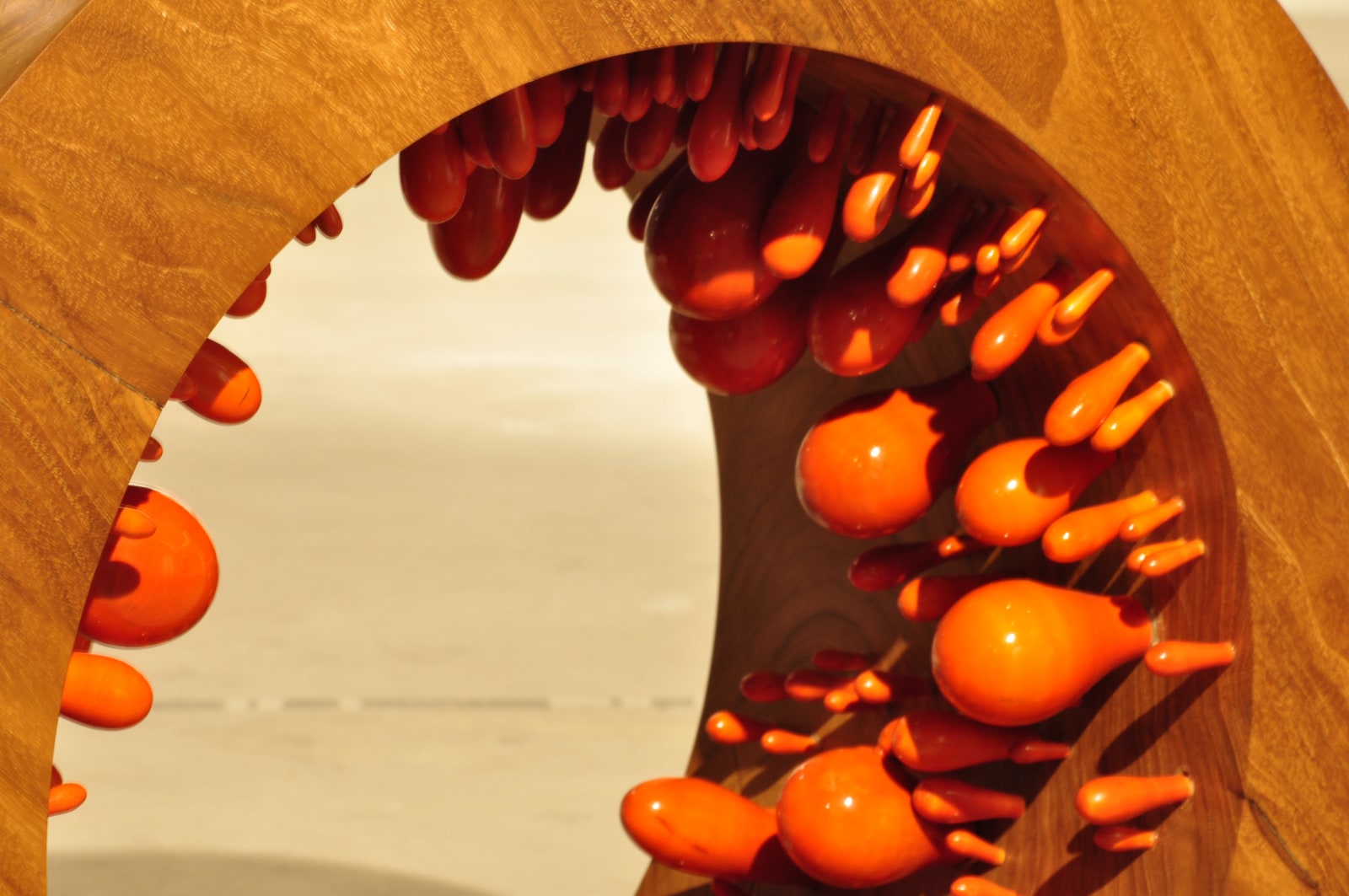
A wooden circle, like a polished industrial drum, sits on the floor as a triumph of craftsmanship. The external surface is impeccably smooth and joined. But the inside has sprouted red polyps in such profusion that it seems somehow alive, as if hirsute with tickly fingers.
This fascinating object by Ranjani Shettar, an artist from Bangalore, is called Flame of the forest. The romantic-sounding title is the common name of an Indian tree (Butea monosperma) with vivid red and orange flowers. Among Hindus, the plant is sacred and Shettar has made a circular temple of it. Carpeted in red nodules, the interior is rich in Freudian associations, both delicate and confronting.
The perfectly regular geometric cylinder makes you think of something machined, but then it freakishly sprouts a lush organic life inside. This combination of efficient exterior and knotty internal tunnel is like an allegory of industrial manufacture, where the machinery of production is ultimately controlled by an internal economy of desire.
The exhibition at the NGV provides a useful and welcome opportunity to view the work of this celebrated international artist. The show labours under a dull and daggy title, Dewdrops and Sunshine, but the sculptural pieces - variously made with tamarind kernel paste, muslin, lacquer, wood, automotive paint, fishing line, beeswax, latex and steel - are ambiguous, intricate, finely crafted and evocative.
An example of the excellent engineering of the works is a pair of nets, each fabricated from thread with bead-like nodules at every intersection. The tiny spheres make up the net and are an essential element in creating the corners of each fabric cell. But though an integral part of the net, the beads are also trapped in it, caught and suspended by the fiber into a sweeping array.
The craftsmanship is remarkable. The irregular cells of string spread out evenly in a large tensile matrix with exponential curves. Almost every piece of line is held tight. Very few of the cells are slack and droopy, even though there are few lateral pressures to stretch them. But perhaps because the work is so perfectly organized, you wonder how it's achieved, and so your attention is drawn from the organic grid to the tacks that hold it taut. Each piece has a similar distraction, as you think about the fishing line that suspends the creations rather than the shapes that dangle for a superior aesthetic purpose.
The best work has a classical modern paradox of geometric form and organic forms, like the networks and circular hole with phallic pile inside. Another is Touch me not, which consists of overlapping waves drawn onto the wall in hundreds of nails with beaded heads. The nails are angled, like grasses in the wind, so that they make waves, insinuating a kind of grain into the graphic movement.
This sense of a racing matrix is energized and imaginative, activating a compulsive swish that runs through our perception of regular things. Incidentally, a similar frisson can be gained from Joanne Mott's works on wooden panels at Mars Gallery in Port Melbourne, where the artist has bored through the layers of fiber with a router to make drifting patterns. Alex Baker, the curator of Dewdrops and Sunshine, writes eloquently and authoritatively about Shettar's installations, especially in their references to process, experience and other artists.
But some of Shettar's works still seem to lack inherent content, especially the pieces apparently related to the physiological response to sunlight and the reflex to sneeze in bright light. On their own, they're interesting ideas (and far from trivial) but the elegant artistic creations speak in a language that is more platonic than allergenic.
Shettar's work is ambitious and represents a kind of grand manner in sculptural conceptualism that isn't overburdened by too many concepts. The work contains ideas but they aren't especially challenging ideas; and meanwhile, the concepts are so sumptuously married to a lyrical monumentality that they tend to the formalesque.
-Robert Nelson